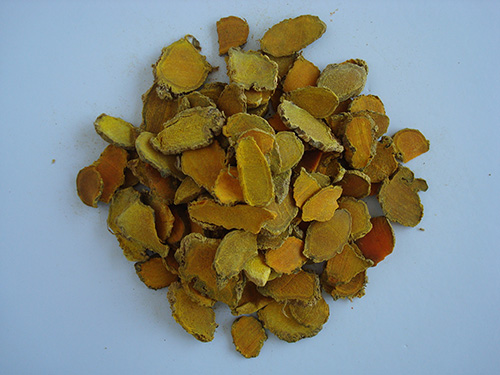Turmeric Root

Botanical name: Curcuma longa L.
Also known as Indian saffron and yellow root, this bright yellow powder is the dried and ground rhizome of the Curcuma longa root, which is a member of the ginger (Zingiberacea) family. Turmeric is a tropical plant with yellow flowers and leaves that are dark green above and light green below. The rhizomes have a brownish-yellow, somewhat scaly outer skin and a bright orange-yellow flesh, which smells spicy when bruised. The health benefits of turmeric- which has a long tradition of use in Ayurvedic and Chinese medicin -- remains a hot topic among natural health advocates.
Indispensable in curry powders and East Indian cooking, turmeric is also used in prepared mustards and pickles, dressings, eggs and rice dishes. A dye and condiment in ancient times, the common name for turmeric comes from the Latin terra merita, or meritorious earth, a reference to its mineral pigmentation.
The early Sanskrit name of turmeric, haridra, means yellow wood. It was used in cooking by the early Sumarians and Assyrians, who received it from India. Marco Polo noted in 1280 that turmeric grew as a vegetable with all the properties of saffron, though he recognized that it was another spice. It reached China in the 7th century and Africa in the 13th century. It was known as Indian saffron. Turmeric has been used in Hindu rituals. Even today, it"s associated with fertility and prosperity. During a traditional Hindu wedding ceremony, the bride has a turmeric paste "painted" onto her face and hands, for luck.Turmeric may also be used as a cloth dye and given as a gift on special occasions, such as a visit to a pregnant woman. Ayurveda, Siddha, Unani and other traditional medicine systems practiced in India have relied on this pungent spice for centuries. It was also mentioned in early herbals as an ingredient in medicines.
Suggested Uses:
The golden hue of turmeric brightens curries, condiments, and egg, fish, and grain dishes. Its taste is warmly aromatic--a bit like ginger and pepper. In India turmeric is often used to color sweet dishes, while in Morocco it"s used to spice meat, (especially lamb) and vegetables. It"s used with fish, in baked goods, meat and meat products, prepared mustards and pickles, broths, cheeses, dressings, grains, egg recipes, and soups. Try it with artichokes and potatoes and in rice dishes. And combine it with coriander and cinnamon for a spicy meat or poultry rub.